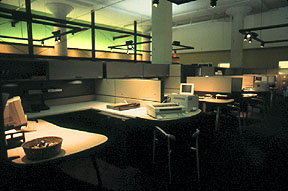|
 Employees
are spending more time in the office, not less. Companies need to have a
carrot or two to attract top workers. And one of those carrots is a better
office environment. Employees
are spending more time in the office, not less. Companies need to have a
carrot or two to attract top workers. And one of those carrots is a better
office environment.
According to Jeffrey N. Morgan, a principal with
Interspace, Inc., a Philadelphia corporate interior design firm, office
designs have begun to show a lot more flexibility and user control.
"Technology has changed the way America conducts business," he
said. Add to this new concepts of management and the result is corporate
America's search for alternative office environments that cut costs, as
well as attract new staff, increase productivity, and communicate the
company's message, which, today, leans towards one of interaction and
flexibility.
"Unfortunately, few companies have jumped at these
alternatives. "We program, design and build over a million square
feet a year,'' said Eric Rymshaw, president of Diversified Interiors,
Philadelphia-based corporate interior designers. "Companies like
Bristol-Myers Squibb are beginning to look seriously at office design
alternatives, but most firms are still status quo.''
But embracing these new concepts is becoming a
competitive necessity. According to Rymshaw, one reason has been the need
to attract and keep highly trained staff. "Good employees are hard to
find and keep happy,'' he added. "They want to be comfortable while
they work, so the trend is to make the office an appealing environment to
work in."
A Pleasant Environment Makes a Happy
Worker
Business executives love statistics. And surprisingly, there's a lot of
them that prove a pleasant environment makes a happy worker--and a happy
worker is a productive worker.
Some companies, like Bristol Meyers Squibb, for whom
Rymshaw's firm has done a lot of work, have not only done over office
space but added amenities to keep workers happy. For instance, they now
have what they call a Main Street--a small village shopping center,
featuring all the food services, a shop where they can buy baked goods to
take home, a credit union, a shoeshine, a hair dresser, and a company
store. The health club and cafeteria act as anchor store to this company
mall. "This Main Street features all the daily services workers need
to keep them on site," said Rymshaw. "Normally people would
drive off the site to do their daily errands. Here, they can do them right
there in the company. It's a clever way of keeping workers there, but at
the same time, it makes it easier for workers to accomplish their daily
work. A lot of companies have always had a lot of these things but not in
one place."
"We believe and our client, Bristol Meyers Squibb,
believes that this reconfiguration will be a significant benefit in hiring
employees because the company is providing a technologically advanced
office environment," he added. "It's what a lot of young people
coming out of school are looking for. It provides employees with an
environment where they have control over their own space and that makes
them more productive."
But Rymshaw believes that more significant than the
benefit to hiring is the benefit redesign has to retention.
"Employees' jobs are easier because their tools are easier and
they're happier, thus they're more satisfied, more productive and stay
longer."
Unfortunately, in today's business world, many offices
look alike. There's almost no connection between what employees are doing
and how the space in which they work is designed. That was the situation
SEI, an investment firm, found itself in during the early '90s. The
company was a bureaucratic house of cards with infighting among
departments and marginal use of computers, according to Murray Lewis,
company spokesman.
"Even though our bottom line was healthy, our CEO,
Al West, chose to reconfigure the company," said Lewis. "We
flattened the organization, put everyone on teams, and eliminated all the
secretaries. Over several years, we've eliminated all private offices, cut
cubicle walls in half, moved to a university-like setting, and finally
eliminated the dividers entirely. There was a lot of resistance at first:
Over the first three years, 50 percent of the staff quit."
However, that radical kind of reorganization requires
the willingness of top executives to fight for change. Generally,
stockholders don't support management by upheaval, especially if the
company is turning a profit. Increasingly though, the bottom line and
increased productivity support the redesign.
The Bottom Line
There's no question that flexibility costs more money initially. "For
companies with 100 percent churn, how many times do they have to call a
furniture installer to reconfigure, and how many times do they have to
call an electrician to rewire?" said Morgan. "With the new
systems, a firm can reconfigure with its own maintenance staff. And it
doesn't need an electrician. Everything is plug and play; nothing is
hardwired. So a company spends 15-20 percent more up front, but every time
an employee moves, it saves several hundred dollars per workstation. So if
it moves 1,000 workstations per year, that's a lot of money saved."
"The functionality of our new design is paying off
handsomely," said Heilly of GMAC. "We've seen significant
savings--about $200,000 a year--so far."
"Reconfiguration isn't cheap," said Rymshaw.
"It's amazing how many companies go back to their original plan when
they find out how much it will cost for the conversion."
|
